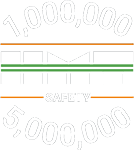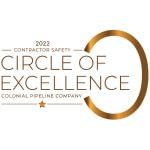By Allie Alderson and Sergey Eggers
Tank design plays a critical role in the economic and environmental performance of petroleum storage facilities. Design choices profoundly influence tank safety as well. Fortunately, many of the design features that reduce product loss and emissions also make tanks safer to operate, maintain, and inspect. If you’re an owner-operator working to balance economic and environmental pressures, accident prevention, and worker safety, this should come as welcome news.
One significant tank design element is the choice of floating roof. Internal floating roofs (IFRs) – specifically suspended ones – are the optimal design for reducing emissions that cause environmental damage and costly product loss. This article looks at why suspended IFRs also offer safety benefits over both traditional steel IFRs and external floating roofs (EFRs). We will also review why IFR tanks are safer than EFR tanks, regardless of whether the floating roof has cable suspension or leg supports.
Suspended Internal Floating Roof Tanks Provide Safer Access for Maintenance, Repair, and Inspection
Among the environmental and economic advantages of a suspended IFR, the lack of internal supports stands out. Suspending an IFR replaces traditional leg supports with hanging cables that require no deck penetration. Suspending an IFR from a self-supported fixed roof (typically an aluminum dome) goes even further by eliminating the need for columns that support a cone roof and must pass through the IFR deck.
While the elimination of fixed and floating roof supporting structures has obvious advantages for emissions control and product loss avoidance, it provides a major safety advantage as well. Access for inspection, cleaning, and maintenance is greatly enhanced by doing away with traditional support structures.
In tanks with traditional IFRs, the adjustable legs are retracted to a height of about three feet during normal operation. This allows the floating roof to ride down to a near-empty condition in the tank before reaching the limit set by the legs. Economics drive the use of a low setting because the closer to empty the tank is allowed to be in normal operation, the greater the inventory that is available to the owner-operator to sell or use. The volume of liquid that is required to remain in the tank, known as dead stock or heel, represents trapped value. The low leg setting allows the tank owner to minimize heel.
Unfortunately, the low leg setting for operations conflicts with the desired position of the floating roof when the tank comes out of service and is emptied of product. Adjustable legs are typically set at six feet for access under the IFR during maintenance and repair. To make the leg setting change from three feet to six feet, workers must either enter from above while the tank is in service and adjust the legs or perform a jacking operation under the roof after the tank has been emptied. Both methods are hazardous, as is the reverse process to lower the legs when the tank is put back in service. Suspending the IFR sidesteps this process and makes tank operations, inspections, and repairs considerably safer as a result. Consider the following benefits:
- No confined space entry needed to change roof position. Because the roof is suspended, its low limit height can be adjusted from the suspension mechanism on the exterior at the top of the tank. There is no need to enter while it is in service to make the adjustment.
- No legs to work around. Without legs or columns, the tank is dramatically easier and safer to clean, de-gas, and inspect. Areas needing repair are far easier to access and work on.
- The IFR can be pinned at any position to allow clear access for equipment and personnel. Work that requires bringing construction equipment inside the tank is a dangerous challenge. While telescoping leg supports are limited to a few feet of adjustment, cable supports can have high and low settings that are many feet apart. This allows a high setting of 12-15 feet that provides ample clearance when larger equipment needed for maintenance and repair.
Domed IFR Tanks Offer Decisive Safety Advantages
EFRs are highly valued for the direct access and visualization they allow despite the significant environmental and economic drawbacks associated with wind-promoted evaporation that can be eliminated with a dome. The use of EFRs also poses safety concerns that result from their exposed nature and their basic configuration. In contrast to EFR tanks, a domed IFR tank:
- Eliminates snow and ice hazards. A buildup of snow or ice on an EFR can knock a rolling ladder off its track or ice it over. That’s a safety risk for workers who need access to the top side of a floating roof. With a suspended IFR, all such maintenance takes place out of the weather.
- Eliminates potential drain issues. EFRs can be prone todrain system malfunction caused by damage to the drain piping/hose through normal operation. In these cases, a backflow of product will seep onto the surface of the EFR. Domed IFRs, on the other hand, shed precipitation and require no floating roof drain and therefore eliminate the associated maintenance and risk related to drain systems.
- Eliminates corroded legs. Rain, snow, and saline winds also corrode legs, giving rise to leaks and other performance failures that threaten human and environmental health. A suspended IFR has no legs and eliminates that risk. Additionally, an IFR, suspended or not, is protected from corrosion risk related to the outside elements.
- Eliminates rolling ladder. A rolling ladder is not only hazardous just when it ices over – it is inherently dangerous. Suspended IFRs eliminate the need and therefore the hazard of this system which imposes unbalanced loads onto the EFR, is prone to icing, and can be difficult to maintain.
- Provides natural lightning protection. An aluminum dome functions as a Faraday cage, directing to the ground through the dome structure and tank shell. This provides protection from direct lighting strikes to an EFR which can cause vapors to ignite and create a tank fire.
Optimal Design Choices Support Safety and Performance
By designing new tanks and retrofitting existing tanks with a domed and suspended IFR, you can make your facility inherently safer to operate and maintain. As an industry professional, you are already aware that a safer operation protects personnel, the community, the environment, the economic value of the product, and the facility’s reputation. Incorporating the above tank design methodology into your operational and safety plans can help to dramatically enhance your tank safety and performance.
Allie Alderson is the Director of Sustainability at HMT. Sergey Eggers is the General Manager of Products Engineering at HMT. HMT is the global leader in above-ground storage tank solutions and a key resource for the oil and gas industry for emissions reduction and environmental solutions.


